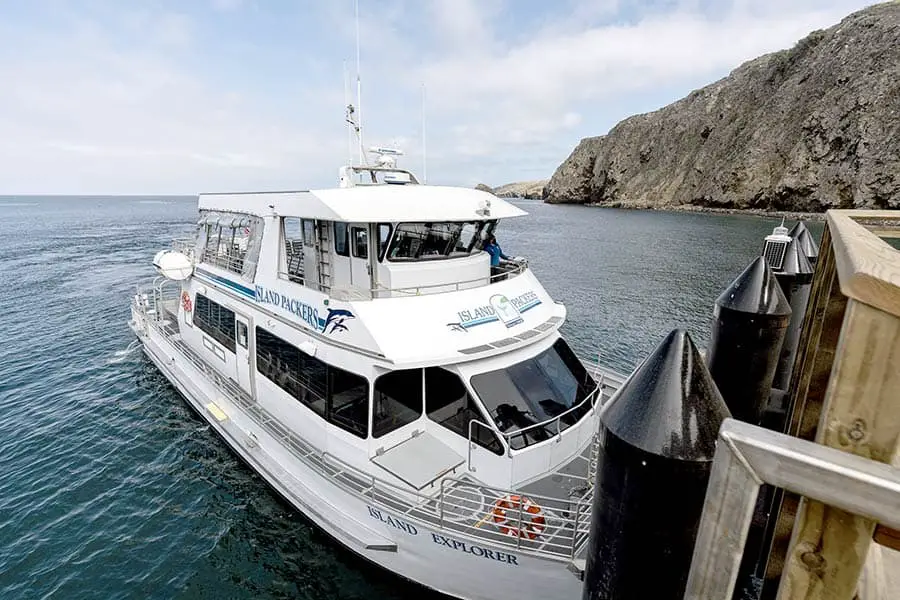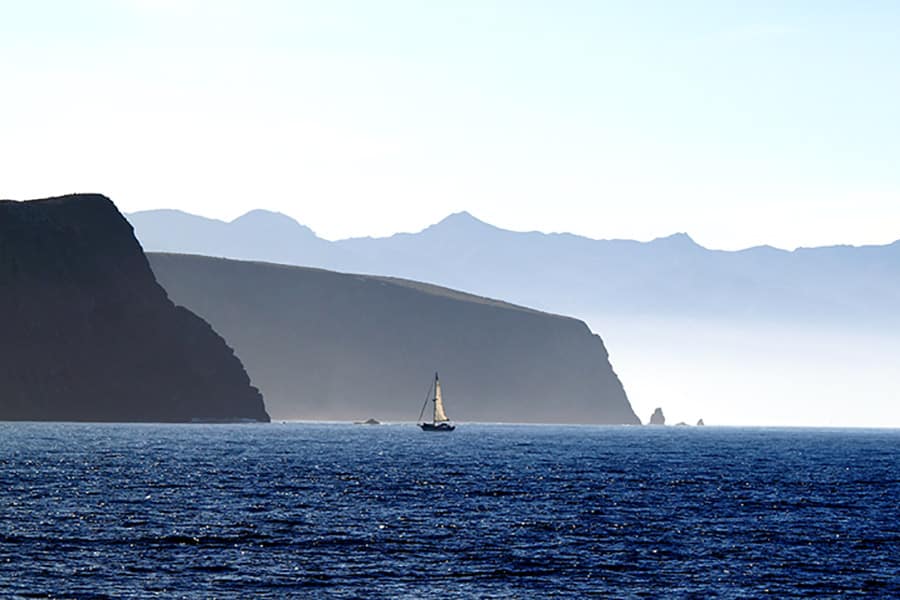
We all know California is beautiful. It has beaches, forests, mountains, even volcanoes. You might also know that just off that Pacific coastline are several islands. But, as you envision these islands off the western coast, you may be wondering which of these islands is California’s largest?
Santa Cruz Island is the largest island in California. It is one of the Channel Islands and is over 96 square miles of diverse natural wonder. The island is over 21 miles long and is home to year-round springs and streams; and one of the deepest sea caves in the world.
So what does one do when they get to this diverse island? What types of beaches does it have? What accommodations does it offer its guests? How long are its hiking trails? Read on to find out all you’ll ever need to know about this “Island of the Sacred Cross.”
Santa Cruz – California’s Largest Island
Approximately twenty miles off the coast of Southern California is the largest island in California, Santa Cruz. Santa Cruz is one of the remarkable Channel Islands, a group of protected islands with incredible scenic natural areas.
Hugged by the Pacific Ocean on all sides, Santa Cruz is about 25 miles south of Santa Barbara Beach, 22 miles southwest of Ventura, and 42 miles west of Malibu. It is a vision of broad valleys, rugged coastlines, looming peaks, and a variety of wildlife.
Santa Cruz Island covers 62,000 acres and has a beautiful 77-mile shoreline. The island’s elevation varies from sea level to over 2,450 feet at Diablo Peak. The island is a whopping 24-miles long and, in some places, can reach 6 miles in width.
Once hovering near ecological ruin, it is now an example of a flourishing island restoration project for other conservation endeavors around the country to learn from.
In 1978, The Nature Conservancy bought the majority of Santa Cruz Island. It now possesses the western 76 percent of the island.

Visitors can explore the Nature Conservancy side of the island by booking a trip with Island Packers or by purchasing a landing permit to arrive at the island using their own boat.
Landing permits are only good for use during the daytime, so no overnight camping is allowed.
It is also essential to note that pets are not allowed due to the island’s delicate animal and plant habitats.
The eastern 24 percent of the island is owned and managed by the National Park Service, and it is the eastern side of the island where camping enthusiasts go since the western part is off-limits for campers.
These days, Santa Cruz is an unspoiled mecca for the outdoor enthusiast. Aside from the spectacular diversity of its wildlife, it is an ideal location for those who love to adventure outdoors. These adventures usually take the following forms on the eastern side of Santa Cruz:
Amazing Hiking Trails
Visitors can enjoy the beauty of Santa Cruz Island by hiking the trails that traverse the eastern section of the island, providing visitors with spectacular hiking opportunities. These trails range from Scorpion Valley’s signed, groomed, reasonably flat paths to the Montañon region’s rough and steep routes.
The hiking trails range from easy half-mile hikes to strenuous 18-mile treks; therefore, you will find hiking options no matter your skill level. However, remember that hiking isn’t permitted beyond the park boundary onto the Conservancy property.
Bay Area Answers Fun Fact: During the mid-1800s, a sheep ranch was established on Santa Cruz Island, and the number of sheep grazing on the island reached 24,000 head.
Primitive Camping
Scorpion Canyon Campground offers primitive camping sites and is the only campground on the island. (No glamping here.) Scorpion Canyon is considered the most family-friendly campground on the islands. I’ll go into more detail about the regulations on the campground later in this post.
Wild & Wet Water Fun
Once you set up your campsite, it’s time to get wet. That’s because Scorpion Beach is known all over for diving, snorkeling, kayaking, and swimming. But keep in mind, there aren’t any lifeguards on the island, so you swim at your own risk.
If you have a kayak, you won’t be disappointed on this trip because you will have lots of opportunities to view the island’s fantastic wildlife, beaches, birds, and rugged wildness.
Other Posts of Interest
- Is Mount Tamalpais Worth Visiting?
- Where Do Cruise Ships Dock In San Francisco?
- Where Are The Farallon Islands?
- Does California Have Volcanoes?
Viewing Nature
Once you’re back on dry land, be sure to take in the uniquely varied flora and fauna. For example, the island is home to the island scrub-jay. This beautiful blue bird is unique to Santa Cruz Island, and believe it or not, this bird only lives right here on the island. You won’t find it in any other place.

Another unique species you will see on Santa Cruz is the island fox. The island fox population was decimated in the late 20th century, and due to conservation efforts, it is now making a comeback. Out of the 8 Channel Islands, the island fox inhabits 6 of them, and it only lives on this handful of islands.
The island’s weather allows plants to bloom year-round and produce a beautiful tapestry of petals and foliage—the island flourishes with wildflowers that reach peak bloom throughout late winter and spring. Because of the climate, Santa Cruz has an abundance of plant species, 800 and counting. It is also home to eight species of plants found nowhere else in the world.
Can You Stay Overnight on Santa Cruz Island?
You most certainly can stay overnight on Santa Cruz Island, but this island is a far cry from posh bed and breakfasts or chic spas. Therefore, this overnight expedition is going to require some planning. In fact, the rugged nature of the trip is a selling point to most people that go there.
There aren’t any services or lodging on the island. In fact, guests must carry all their own food and water. The only resources are at Scorpion Canyon Campground, where potable water is available.
Rudimentary camping is available year-round at the one and only campground on Santa Cruz, Scorpion Ranch. Scorpion Ranch has 31 campsites, and up to 15 people are allowed per campsite. You will have to trek a little with your supplies, though, as Scorpion Ranch Campground is half a mile from the landing.
You have to make reservations to camp, and since spaces are limited, you will want to reserve early, and a $15.00 per night fee is charged to help provide the maintenance of the grounds. To make a camping reservation, go to recreation.gov.
I’ve mentioned that the campgrounds are pretty bare, so I want to take a moment to clarify some crucial regulations of the camping at Santa Cruz:
- No fires. Use only gas camp stoves.
- No trash containers are provided-you must pack out what you bring in.
- Keep your food secure. Store all food in animal and bird-proof containers.
- Do not feed the wildlife.

How Do You Get to Santa Cruz Island?
When visiting Santa Cruz, you certainly should plan in advance because it is only accessible by park concessionaire boats or privately owned boats.
Santa Cruz Island offers two sites that the majority of guests use. Both landings (Scorpion Anchorage and Prisoners Harbor) are situated on the island’s northern side.
The travel time to Scorpion Anchorage is slightly over an hour away from Ventura Harbor on the mainland. Prisoners Harbor, however, is about one and a half hours.
Frequently, the boats land at Scorpion Anchorage to offload passengers and gear first before continuing to Prisoners Harbor. During these trips, it can take more than 2 hours along the scenic shore of Santa Cruz Island.
How Do You Get Around on Santa Cruz Island?
Since Santa Cruz is part of the Channel Island National Park, almost everything is protected, including plant life, wildlife, and other natural features. And walking/hiking is the sole means of getting around on the island, that’s it, and that means no bikes either.
Does Anyone Live on Santa Cruz Island?
Santa Cruz has a pretty rich history and was inhabited by several different cultures. Originally, the Chumash people resided there for thousands of years. Eventually, Spanish settlers occupied the island and, during the Civil War, it was a busy rancher colony.
Today, the only people on the island are visiting tourists and the rangers who maintain and patrol it.

Does Santa Cruz Island Have a Beach?
With 77 miles of cobblestone and sand, the shoreline of Santa Cruz gives visitors the key to all those water sports I talked about before. They are known for easy beach access, glass-clear ocean waters, and extensive kelp forests to patrol with your snorkel. The beaches are accessed through hiking trails with various levels of difficulty. Let’s take a look at two of them.
Chinese Harbor, its northern cobblestone beach, is a model of a rugged untouched shore; it is practically unaffected by the modern world. It’s known for its rough surf and the sight of its pink and yellow rocks. It is also the endpoint of a 15-mile hike along the Del Norte trail.
Smugglers Cove, a beach on the eastern side of the island, is a popular destination for travelers, and no trip to Santa Cruz is complete without visiting here.
Its scenic views can’t be beaten, including looking down on the beach as you approach it; cypress groves and wildlife pepper the landscape that begins when you leave Scorpion Anchorage and ends with the cove.
Make Santa Cruz Your Next Destination
The Golden State is known for its remarkable natural splendor. Make Santa Cruz Island your next destination; it will help you embrace the rich natural beauty of the state. Whether you are a bird watcher, hiker, a kayaker, or just enjoy majestic views, there is something for everyone on the island of Santa Cruz.





